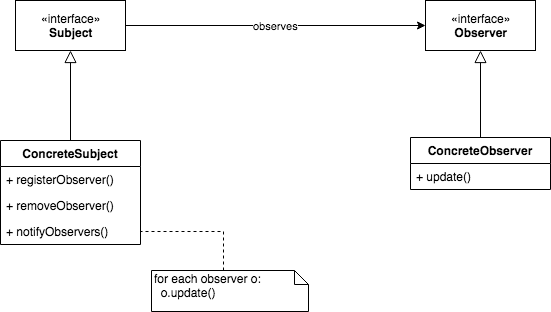Table Of Content

The Observer Pattern helps decouple the weather monitoring system from the components interested in weather updates. Each component can register as an observer, and when the weather changes, the observers are notified. This way, adding or removing components doesn’t affect the weather monitoring system.

Design Patterns in Python: Facade
As described above, when you have a design a system where multiple entities are interested in any possible update to some particular second entity object, we can use the observer pattern. While the library classes java.util.Observer and java.util.Observable exist, they have been deprecated in Java 9 because the model implemented was quite limited. Different parts of your application need to be updated when the weather conditions change. They are not pieces of code or libraries that can be imported and used in the development of software or solving a particular problem.
Observer Pattern’s Relations with Other Patterns
In contrast, the Observer pattern focuses on subscription-based notifications without encapsulating requests. Whenever a user sends a message, all other users within the chat, acting as observers, will receive and display the message. While this approach keeps the observer interface small, comparing the current state with the new one to identify the changes can be challenging and time-consuming. Remember that our dependency rule applies only to implementation types at compile time.
JavaScript
Whenever any new message will be posted to the topic, all the registers observers will be notified and they can consume the message. Based on the requirements of Subject, here is the base Subject interface that defines the contract methods to be implemented by any concrete subject. The typical application cases include GUIs (graphical user interfaces), which provide users with an easy-to-use interface for communicating with software. As soon as data is changed, these changes have to be updated in all GUI components – a scenario ideally covered by the subject/observer structure of the observer pattern.
Based on the book:
In this example, the WeatherStation class is the subject, and PhoneDisplay and TVDisplay are the observers. When the WeatherStation's temperature changes, it calls the `notifyObservers()` method, which calls the `update()` method on each observer. The observers then update their temperature display accordingly. Imagine having a toolbox of tried-and-true solutions readily available.
By understanding and applying patterns such as Singleton, Factory, Observer, and others, you can improve the quality, scalability, and maintainability of your software projects. Subject is an object having methods to attach and detach observers to a client object. We have created an abstract class Observer and a concrete class Subject that is extending class Observer.
The observers then need to ask for the changed status by means of a separate method request. Besides other well-known patterns such as the visitor pattern or the singleton pattern, the observer pattern belongs to this collection of practical design patterns. We explain what the observer design pattern can do, present it in a UML diagram, and cover the strengths and weaknesses of the pattern. In this UML class diagram, the Subject class does not update the state of dependent objects directly. Instead, Subject refers to the Observer interface (update()) for updating state, which makes the Subject independent of how the state of dependent objects is updated. The Observer1 and Observer2 classes implement the Observer interface by synchronizing their state with subject's state.
Artistic Patterns For The Home From Imrik Studio
Ordinary Observer Test Is 'The Sole Controlling Test for Determining Anticipation of Design Patents' - IPWatchdog.com
Ordinary Observer Test Is 'The Sole Controlling Test for Determining Anticipation of Design Patents'.
Posted: Wed, 18 Sep 2019 07:00:00 GMT [source]
‘ConcreteObserver’ is an implementation of the ‘Observer’ interface. This can be prevented if the subject holds weak references to the observers. You can often experience this problem when working with classes of the graphical user interface. For example, you created custom button classes, and you want to let the clients hook some custom code to your buttons so that it fires whenever a user presses a button. Command encapsulates requests as objects, allowing parameterization and queuing of requests.
Design Patterns - Observer Pattern
In other scenarios, tightly coupled objects can be a better option because the compiler is able to detect errors at compile time and optimize the code at the CPU instruction level. It is often used for implementing distributed event-handling systems in event-driven software. Design patterns are reusable solutions to common problems that arise during software development. They provide a shared vocabulary and best practices for designing scalable and maintainable software systems. In this article, we'll explore some of the most popular design patterns, including Singleton, Factory, Observer, and others. By understanding and applying these patterns, you'll be better equipped to tackle complex software development challenges.
The customer could visit the store every day and check product availability. But while the product is still en route, most of these trips would be pointless.
Even programs that work with datasets to be visualized (whether classic tables or graphic diagrams) also benefit from the design pattern structure. The observer design pattern – often abbreviated to observer pattern – is one of the most popular pattern templates for designing computer software. It provides a consistent way to define a one-to-one dependency between two or more objects in order to relay all changes made to a certain object as quickly and simply as possible. For this purpose, any objects that act as observer in this case can register with another object. The latter object – referred to as a subject – informs the registered observers as soon as it has changed.

No comments:
Post a Comment